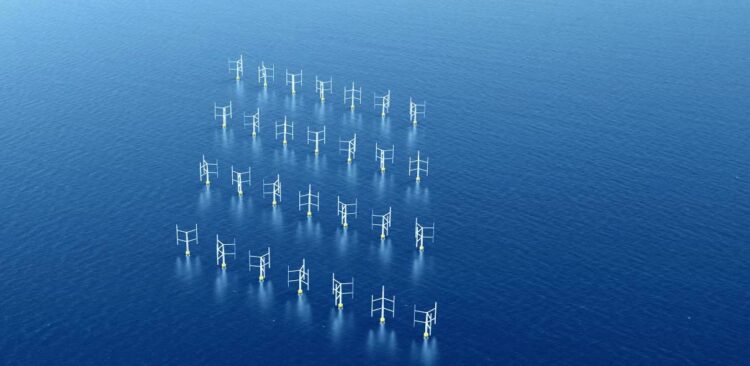Vertical turbines could be the future for wind farms

Farm of Vertical Axis Wind Turbines
Credit: Oxford Brookes University
The now-familiar sight of traditional propeller wind turbines could be replaced in the future with wind farms containing more compact and efficient vertical turbines.
New research from Oxford Brookes University has found that the vertical turbine design is far more efficient than traditional turbines in large scale wind farms, and when set in pairs the vertical turbines increase each other’s performance by up to 15%.
A research team from the School of Engineering, Computing and Mathematics (ECM) at Oxford Brookes led by Professor Iakovos Tzanakis conducted an in-depth study using more than 11,500 hours of computer simulation to show that wind farms can perform more efficiently by substituting the traditional propeller type Horizontal Axis Wind Turbines (HAWTs), for compact Vertical Axis Wind Turbines (VAWTs).
Vertical turbines are more efficient than traditional windmill turbines
The research demonstrates for the first time at a realistic scale, the potential of large scale VAWTs to outcompete current HAWT wind farm turbines.
VAWTs spin around an axis vertical to the ground, and they exhibit the opposite behaviour of the well-known propeller design (HAWTs). The research found that VAWTs increase each other’s performance when arranged in grid formations. Positioning wind turbines to maximise outputs is critical to the design of wind farms.
Professor Tzanakis comments “This study evidences that the future of wind farms should be vertical. Vertical axis wind farm turbines can be designed to be much closer together, increasing their efficiency and ultimately lowering the prices of electricity. In the long run, VAWTs can help accelerate the green transition of our energy systems, so that more clean and sustainable energy comes from renewable sources.”
With the UK’s wind energy capacity expected to almost double by 2030, the findings are a stepping stone towards designing more efficient wind farms, understanding large scale wind energy harvesting techniques and ultimately improving the renewable energy technology to more quickly replace fossil fuels as sources of energy.
Cost effective way to meet wind power targets
According to the Global Wind Report 2021, the world needs to be installing wind power three times faster over the next decade, in order to meet net zero targets and avoid the worst impacts of climate change.
Lead author of the report and Bachelor of Engineering graduate Joachim Toftegaard Hansen commented: “Modern wind farms are one of the most efficient ways to generate green energy, however, they have one major flaw: as the wind approaches the front row of turbines, turbulence will be generated downstream. The turbulence is detrimental to the performance of the subsequent rows.
“In other words, the front row will convert about half the kinetic energy of the wind into electricity, whereas for the back row, that number is down to 25-30%. Each turbine costs more than £2 million/MW. As an engineer, it naturally occurred to me that there must be a more cost-effective way.”
The study is the first to comprehensively analyse many aspects of wind turbine performance, with regards to array angle, direction of rotation, turbine spacing, and number of rotors. It is also the first research to investigate whether the performance improvements hold true for three VAWT turbines set in a series.
Dr Mahak co-author of the article and Senior Lecturer in ECM comments: “The importance of using computational methods in understanding flow physics can’t be underestimated. These types of design and enhancement studies are a fraction of the cost compared to the huge experimental test facilities. This is particularly important at the initial design phase and is extremely useful for the industries trying to achieve maximum design efficiency and power output.”
###
The research Numerical modelling and optimization of vertical axis wind turbine pairs: A scale up approach was published in the International Journal of Renewable Energy (ELSEVIER)
All latest news from the category: Power and Electrical Engineering
This topic covers issues related to energy generation, conversion, transportation and consumption and how the industry is addressing the challenge of energy efficiency in general.
innovations-report provides in-depth and informative reports and articles on subjects ranging from wind energy, fuel cell technology, solar energy, geothermal energy, petroleum, gas, nuclear engineering, alternative energy and energy efficiency to fusion, hydrogen and superconductor technologies.
Newest articles

First-of-its-kind study uses remote sensing to monitor plastic debris in rivers and lakes
Remote sensing creates a cost-effective solution to monitoring plastic pollution. A first-of-its-kind study from researchers at the University of Minnesota Twin Cities shows how remote sensing can help monitor and…

Laser-based artificial neuron mimics nerve cell functions at lightning speed
With a processing speed a billion times faster than nature, chip-based laser neuron could help advance AI tasks such as pattern recognition and sequence prediction. Researchers have developed a laser-based…

Optimising the processing of plastic waste
Just one look in the yellow bin reveals a colourful jumble of different types of plastic. However, the purer and more uniform plastic waste is, the easier it is to…



